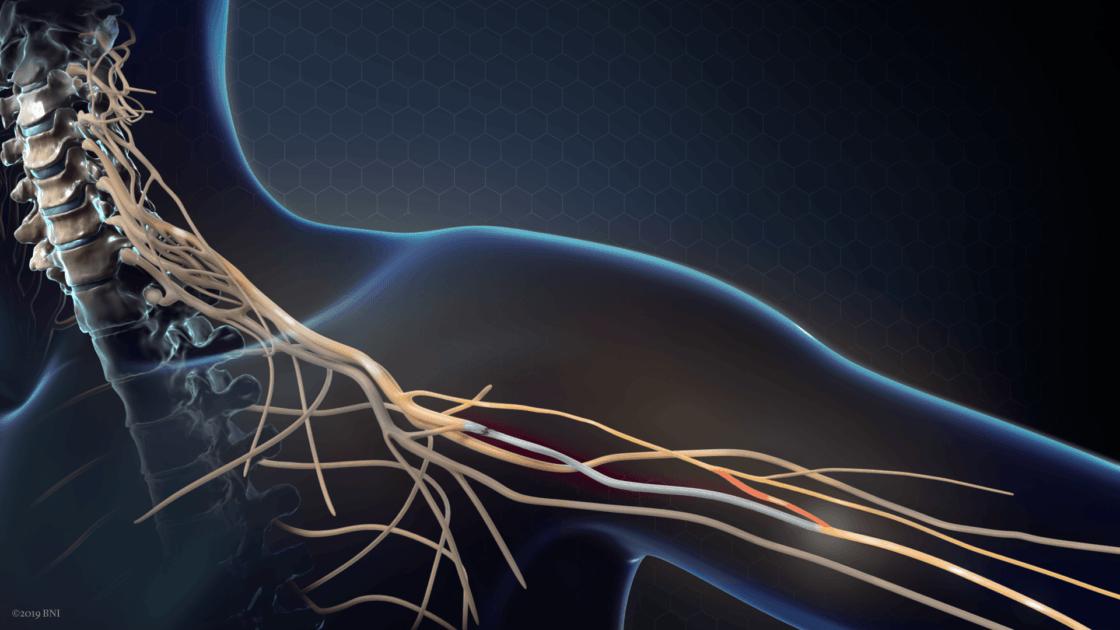
Nerve Transfer Surgery: Reanimating the Hand After Spinal Cord Injury
First, the brain formulates the plan and sends instructions to the spinal cord via nerve pathways in the brainstem.
Then, motor neurons in the spinal cord carry the messages to the appropriate peripheral nerves extending from the spinal cord—in this case, the median, ulnar, and radial nerves. These nerves branch off the spinal cord in a network known as the brachial plexus, which is located in the shoulder area, and extend into the arms and hands.
Finally, the peripheral nerves power the hand and arm muscles to grasp and lift the coffee cup. Sensory nerves in the fingers send messages back to the brain saying the cup is in hand.
When an injury occurs to the central or peripheral nervous system, either from trauma or disease, it can disrupt this entire communication process. This can affect a person’s ability to perform everyday tasks, such as holding and lifting a cup to take a drink.
This where Dr. Rory Murphy, a neurosurgeon at Barrow Neurological Institute, is working to make a difference for his patients.
“I’ve always been fascinated by how to use surgery and technology to help patients recover function that they’ve lost from either a brain, spinal cord, or peripheral nerve injury,” he said. “One of the new, exciting opportunities is utilizing nerve transfers to help patients with cervical spinal cord injuries reanimate their hands.”
How Does Nerve Transfer Surgery Work?
Traditionally, surgeons have used tendon transfer to restore hand and arm function in people with spinal cord injuries in the neck, also known as the cervical region. This procedure involves taking a tendon that’s attached to a healthy muscle, but not crucial to its function, and reattaching it to a paralyzed muscle. This allows the healthy muscle to take over the job of the one that was paralyzed.
Nerve transfer surgery works in a similar way. The surgeon takes a nerve from above the level of injury that is not crucial to an area’s function, or that is redundant to another nerve, and attaches it to a significant nerve below the level of injury.

“That nerve will grow into the other nerve and basically take over its function, allowing patients to recover or at least improve some of the function that they’ve lost,” Dr. Murphy said.
However, unlike tendon transfer surgery, nerve transfer allows for the reactivation of the muscles that are actually meant to perform those lost functions.
Nerve transfer isn’t a new technique. Surgeons have used it to treat peripheral nerve and brachial plexus injuries for many years. However, they’re gaining more knowledge about outcomes in individuals with spinal cord injuries.
“There are more and more patient trials and data showing that this surgery can be beneficial for them,” Dr. Murphy said. “Over the past four years, there have been individual case reports. Now, we’re seeing the first prospective series of patients.”
How Does Nerve Transfer Surgery Compare to Tendon Transfer Surgery?
An Australian study, published in The Lancet in August, evaluated 13 men and three women who had each sustained a traumatic spinal cord injury in the mid-cervical region within the prior 18 months. Most of the participants, who were an average age of 27, sustained their injuries in motor vehicle or sports-related accidents.
Participants underwent single or multiple nerve transfers to restore elbow extension, grasp, pinch, and hand opening. Ten of them underwent nerve transfers for one hand and tendon transfers for the other. Overall, the study looked at outcomes of 59 nerve transfer procedures in 27 arms and hands.
As we gain more knowledge, the surgery is becoming more commonplace but only in specialized centers like Barrow Neurological Institute.
-Dr. Rory Murphy, Barrow Neurosurgeon
At the two-year mark, participants reported becoming significantly more independent. They also performed better in assessments involving picking up and releasing objects of different sizes within a specified amount of time.
The hands reconstructed with nerve transfer had similar outcomes to those reconstructed with tendon transfer. However, the study said nerve transfers resulted in a more natural appearance and feel, and they allowed patients to open their hands more easily. These differences left patients more satisfied with the nerve transfers than the tendon transfers.
Side effects included changes in sensation in the hand and a temporary decrease in wrist strength. Four nerve transfers in three participants failed.
Who Can Benefit from Nerve Transfer Surgery?
Nerve transfer surgery can take at least a year to show benefits because the nerves need time to join together and the muscles often have to be retrained with neuro-rehabilitation, Dr. Murphy said. No patient is known to have recovered their full pre-injury abilities after nerve transfer.
Still, regaining even some hand and arm function can be life-changing for many people with spinal cord injuries.
According to the National Spinal Cord Injury Statistical Center, there are about 17,730 new cases of spinal cord injury each year in the United States. More than half result in partial or total paralysis of the hands and/or arms. Many of these individuals say regaining arm and hand function is their highest priority, as it could drastically improve their level of independence.
Dr. Murphy said an individual may be a good candidate for surgery if they are between the ages of 18 and 70, and they have a complete or an incomplete spinal cord injury between levels C5 and C7. Ideally, the injury should have occurred within the past two years.
“You need to see a specialist to figure out whether you are a good candidate for surgery,” he said. “As we gain more knowledge, the surgery is becoming more commonplace but only in specialized centers like Barrow Neurological Institute.”
